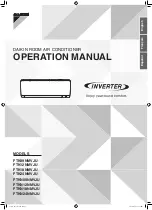
Installation manual
9
REYQ8~16M8W1B
VRVII System air conditioner
4PW23712-1
6.4.
Leak test and vacuum drying
The units were checked for leaks by the manufacturer.
See
figure 12
and refer to
"6.6. Additional refrigerant charge" on
page 10
for nomenclature of the parts in figure 12.
• Confirm that the suction, discharge and liquid line stop valves (and
oil-equalizing stop valve in case of a 18~48 type unit as well) are
firmly closed before pressure test or vacuuming.
• Make sure that valves A + B + C are completely open.
Air tight test and vacuum drying
■
Air tight test: Make sure to use nitrogen gas. (For the service
port location, refer to the "Caution" label attached on the front
panel of the outdoor unit.)
Pressurize the liquid, suction gas and discharge gas pipes (and oil-
equalizing pipe in case of REYQ18~48 type) to 3.8 MPa (38 bar) (do
not pressurize more than 3.8 MPa (38 bar)). If the pressure does not
drop within 24 hours, the system passes the test. If the pressure
drops, check where the nitrogen leaks from.
■
Vacuum drying: Use a vacuum pump which can evacuate to
–100.7 kPa (5 Torr, –755 mm Hg)
1.
Evacuate the system from the liquid, suction gas and discharge
gas pipes (and oil-equalizing pipe in case of REYQ18~48 type) by
using a vacuum pump for more than 2 hours and bring the system
to –100.7 kPa. After keeping the system under that condition for
more than 1 hour, check if the vacuum gauge rises or not. If it rises,
the system may either contain moisture inside or have leaks.
2.
Following should be executed if there is a possibility of moisture
remaining inside the pipe (if piping work is carried out during the
raining season or over a long period of time, rainwater may enter the
pipe during work).
After evacuating the system for 2 hours, pressurize the system to
0.05 MPa (vacuum break) with nitrogen gas and evacuate the
system again using the vacuum pump for 1 hour to –100.7 kPa
(vacuum drying). If the system cannot be evacuated to –100.7 kPa
within 2 hours, repeat the operation of vacuum break and vacuum
drying.
Then, after leaving the system in vacuum for 1 hour, confirm that the
vacuum gauge does not rise.
Stop valve operation procedure
Introduction
Confirm the sizes of the stop valves connected to the system
referring to the table below.
Opening stop valve
1.
Remove the cap and turn the valve counterclockwise with the
hexagon wrench.
2.
Turn it until the shaft stops.
Do not apply excessive force to the stop valve. Doing so may break
the valve body, as the valve is not a backseat type. Always use the
special tool.
3.
Make sure to tighten the cap securely.
Closing stop valve
1.
Remove the cap and turn the valve clockwise with the hexagon
wrench.
2.
Securely tighten the valve until the shaft contacts the main body seal.
3.
Make sure to tighten the cap securely.
For the tightening torque, refer to the table below.
(See figure 11)
CAUTION
■
Always use a charge hose for service port connection.
■
After tightening the cap, check that no refrigerant leaks are
present.
NOTE
Make sure to perform airtightness test and vacuum
drying using the service ports of the stop valve shown
in the table below.
REYQ8~16
Liquid line stop valve
Discharge gas line stop valve
Suction gas line stop valve
REYQ18~48
Liquid line stop valve
Discharge gas line stop valve
Suction gas line stop valve
Oil-equalizing line stop valve
1
2
1
Electric box lid
2
Caution label location
REYQ8
REYQ10
REYQ12
REYQ14
REYQ16
Liquid line stop
valve
Ø9.5
Ø12.7
Suction gas line
stop valve
Ø22.2
(*)
(*)
The model REYQ8 supports on-site piping of Ø19.1 by the accessory pipes.
Ø25.4
(†)
(†) The model REYQ16 supports on-site piping of Ø28.6 by the accessory pipes.
Discharge gas line
stop valve
Ø19.1
(‡)
(‡) The model REYQ8 supports on-site piping of Ø15.9 by the accessory pipes.
Ø19.1
(**)
(**) The model 16 supports on-site piping of Ø22.2 by the accessory
pipes.
Tightening torque N•m (Turn clockwise to close)
stop
valve
size
Shaft (valve body)
Cap
(valve lid)
Service port
Flare nut
Suction line
piping
attached to
unit (1)
Ø6.4
5.4~6.6
Hexagonal
wrench
4 mm
13.5~16.5
11.5~13.9
14~17
—
Ø9.5
33~39
Ø12.7
8.1~9.9
18~22
50~60
Ø19.1
13.5~16.5
Hexagonal
wrench
6 mm
23~27
97~119
Ø22.2
27~33
Hexagonal
wrench
10 mm
36~44
—
22~28
Ø25.4
1
Service port
2
Cap
3
Hexagon hole
4
Shaft
5
Seal












































